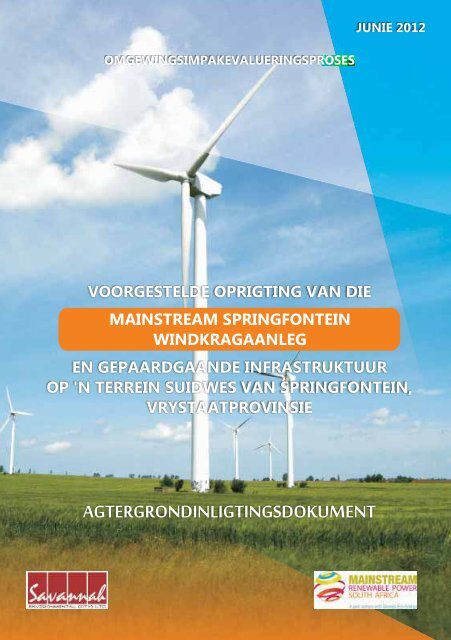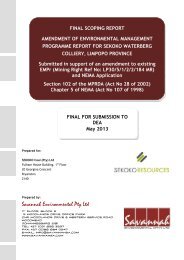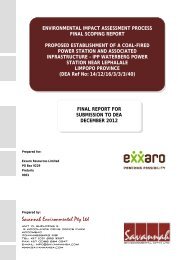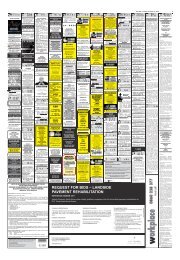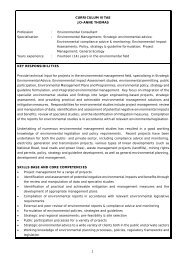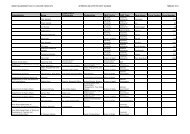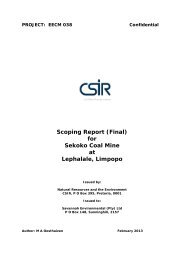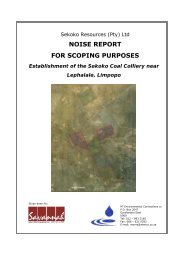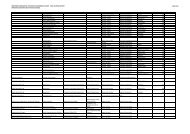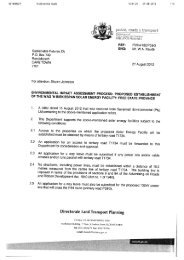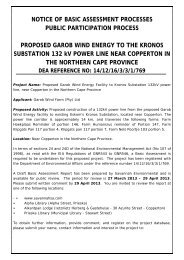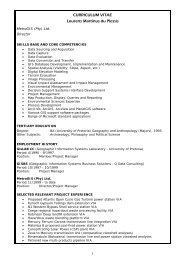11107 Savannah - Savannah Environmental specialist ...
11107 Savannah - Savannah Environmental specialist ...
11107 Savannah - Savannah Environmental specialist ...
Create successful ePaper yourself
Turn your PDF publications into a flip-book with our unique Google optimized e-Paper software.
2<br />
South Africa Mainstream Renewable Power Springfontein (Edms.) Bpk. (hierna “Mainstream”<br />
genoem) stel die oprigting voor van 'n kommersiële windkragaanleg en gepaardgaande<br />
infrastruktuur op 'n terrein in die Kopanong Plaaslike Munisipaliteit. Die terrein wat geïdentifiseer is<br />
vir oorweging in 'n Omgewingsimpakevaluering (OIE), is geleë in die Vrystaatprovinsie, sowat<br />
12 km suidwes van Springfontein. Die voorstel is dat tot 74 windturbines oor 'n breër gebied van<br />
2<br />
sowat 83 km in omvang opgerig sal word. Die voorgestelde aanleg sal as die Springfontein<br />
Windkragaanleg bekend staan. Die aard en omvang van hierdie aanleg word van naderby in hierdie<br />
dokument ondersoek.<br />
DOEL VAN HIERDIE AGTERGRONDINLIGTINGSDOKUMENT<br />
Hierdie dokument poog om u, as 'n belangstellende en/of geaffekteerde party (B&GP), te voorsien<br />
van:<br />
» 'n oorsig van die voorgestelde Springfontein Windkragaanleg;<br />
» 'n oorsig van die Omgewingsimpakevalueringsproses en studies wat onderneem word om die<br />
potensiële impakte van die voorgestelde projek, beide positief en negatief, te evalueer; en<br />
» besonderhede van hoe u by die proses betrokke kan raak, inligting kan ontvang of vraagstukke<br />
kan opper wat u dalk kan raak en/of vir u van belang kan wees.<br />
OORSIG VAN DIE VOORGESTELDE PROJEK<br />
Die windkragaanleg word voorgestel op die volgende plaasgedeeltes (sien die aangehegte kaart):<br />
Die Restant van die plaas Stock Port R283, die Restant van Spioenkop 461, Gedeelte 0 van die plaas<br />
Ou Spioenkop 467, Gedeelte 0 van die plaas MistKuil 412 en Gedeelte 0 van die plaas Bankfontein<br />
519.<br />
Mainstream het op dié terrein besluit vir die ontwikkeling van 'n windkragaanleg op grond van die<br />
windklimaat, beskikbaarheid van grond en die geskikte nabyheid aan die bestaande kragnet.<br />
Die vermoë van die windkragaanleg sal afhang van die mees geskikte windturbine (ten opsigte van<br />
die turbine se vermoë) waarop Mainstream se keuse val. Turbines met 'n vermoë van tussen 1.4 MW<br />
en 4 MW word vir die terrein oorweeg. Die totale aantal turbines wat vir die terrein voorgestel word,<br />
wissel (tussen 30 en 74, afhangend van die soort turbine wat gebruik word). Afhangend van die<br />
uiteindelike turbinekeuse, sal die totale geïnstalleerde vermoë van die voorgestelde aanleg tussen<br />
sowat 85 MW en 170 MW wees.<br />
Aangesien die verrigting van die turbines deur die skommelings in die windhulpbron geaffekteer<br />
word, moet hierdie turbines na behore in die aanleg uitgesprei wees. Die uiteindelike doel agter die<br />
ontwerp en uitleg van die aanleg is om die opwekking van elektrisiteit te maksimaliseer deur<br />
blootstelling aan die windhulpbron, terwyl infrastruktuur-, bedryfs- en instandhoudingskostes,<br />
sowel as maatskaplike en omgewingsimpakte, tot 'n minimum beperk word. Die<br />
voorgestelde turbines sal dus na behore oor die geïdentifiseerde terrein versprei word. Daar word<br />
aan die hand gedoen dat die breër terrein die windturbines sowel as die gepaardgaande<br />
infrastruktuur sal akkommodeer wat vir 'n aanleg van hierdie aard benodig word, wat onder andere<br />
die volgende insluit:
» Windturbines met 'n naafhoogte van tot 120 m.<br />
» Kabels tussen die turbines, ondergronds gelê waar prakties moontlik.<br />
» Interne toegangspaaie na elke turbine.<br />
» n Werkswinkelgebied/kantoor vir beheer, instandhouding en berging.<br />
» n Substasie op die terrein om die roosterkonneksie moontlik te maak.<br />
» Die opsies vir 'n roosterkonneksie is soos volg:<br />
'nInlus<br />
en uitlus van die bestaande Besembos-Signal 132 kV kraglyn wat deur die terrein<br />
loop (op die plaas Stock Port RE/283); of<br />
'n nuwe kraglyn tot by Eskom se Besembos Substasie (suid van Springfontein) wat vir die<br />
toekoms beplan word.<br />
» Permanente windmoniteringsmaste.<br />
Daar word beoog om die Springfontein Windkragaanleg by die Verenigde Nasies se<br />
Raamwerkkonvensie vir Klimaatsverandering te registreer as deel van die Program vir Skoon<br />
Ontwikkelingsmeganismes.<br />
WINDTURBINES<br />
'n Windkragaanleg bestaan uit verskeie windturbines wat aangewend word om die wind se<br />
kinetiese energie vas te vang ten einde elektrisiteit op te wek. Hierdie kinetiese energie word<br />
aangewend om 'n generator aan te dryf wat binne-in die windturbine aangetref word, wat die<br />
energie gevolglik in elektriese energie omsit. 'n Turbine is ontwerp om ononderbroke en met min<br />
instandhouding vir meer as 25 jaar in bedryf te staan. Die konstruksietydperk vir die<br />
windkragaanleg sal oor 'n periode van twee jaar strek. 'n Tipiese windturbine bestaan uit die<br />
volgende vier primêre komponente:<br />
Die Fondasie<br />
Elke turbine sal oor 'n betonfondasie beskik, waarop die basis van die windturbine geanker sal wees.<br />
Hierdie fondasies is tot sowat 2.5 m diep.<br />
Die Toring<br />
Die hoogte van die toring varieer tussen 80–120 m, afhangend van die soort turbine. Die toring is 'n<br />
hol struktuur wat toegang tot die nacelle (turbinehuis) bied ten einde instandhoudingswerk uit te<br />
voer.<br />
Die Nacelle (turbinehuis)<br />
Die nacelle verwys na die beskermende omhulsel waarin die ratkas, generator en windsensor wat<br />
die windrigting identifiseer, aangetref word. Die nacelle beskik oor die vermoë om te draai ten einde<br />
te verseker dat die rotorlemme altyd na die wind gedraai is om die hoeveelheid elektrisiteit wat<br />
opgewek word, te maksimaliseer.<br />
Die Rotor<br />
Die rotor bestaan uit drie lemme en die naaf. Die rotorlemme is normaalweg tot 60 m lank. Hoe<br />
meer omwentelings die rotor maak, hoe meer elektrisiteit word opgewek.<br />
Die hoeveelheid energie wat 'n turbine kan inspan, hang af van beide die windsnelheid en die lengte<br />
van die rotorlemme. Windturbines begin krag opwek teen windsnelhede van tussen 10–15 km/h,<br />
met snelhede van tussen 45–60 km/h wat benodig word vir volle kragbediening. Wanneer<br />
windsnelhede vlakke bereik wat die generator kan beskadig, skakel die turbine outomaties af. 'n<br />
Turbine is ontwerp om met min instandhouding vir meer as 25 jaar ononderbroke te funksioneer.<br />
3
4<br />
Naafhoogte<br />
(~80m tot 120m)<br />
Illustrasie van die komponente van 'n tipiese windturbine<br />
OMGEWINGSIMPAKEVALUERINGSPROSES<br />
Rotorlem<br />
(~40m tot 60m lank)<br />
Ingevolge Artikel 24 en 24D van die Nasionale Wet op Omgewingsbestuur (Wet 107 van 1998),<br />
saamgelees met die OIE-regulasies van Staatskennisgewing R543 – R546, word vereis dat 'n<br />
Bestekopname- en 'n OIE-proses vir die voorgestelde projek onderneem word. Mainstream benodig<br />
magtiging van die Nasionale Departement Omgewingsake (DEA) (in oorleg met die Vrystaatse<br />
Departement Ekonomiese Ontwikkeling, Toerisme en Omgewingsake) ten einde die voorgestelde<br />
projek te onderneem. Ten einde magtiging vir hierdie projek te verkry, moet omvattende,<br />
onafhanklike omgewingstudies ingevolge die OIE-regulasies onderneem word. Hierdie projek is by<br />
die Nasionale DEA geregistreer onder Aansoekverwysingsnommer 14/12/16/3/3/2/365.<br />
'n OIE is 'n doeltreffende beplannings- en besluitnemingswerktuig. Dit bring mee dat die potensiële<br />
omgewingsverwante gevolge wat voortspruit uit die oprigting en bedryf van 'n tegniese aanleg,<br />
geïdentifiseer en na behore bestuur word. Dit bied die applikant die geleentheid om vooraf<br />
gewaarsku te wees teen potensiële omgewingsvraagstukke en bied die geleentheid om die<br />
vraagstuk(ke) waaroor verslag gedoen is in die OIE-verslag asook uit dialoog met geaffekteerde<br />
partye, op te los.<br />
Mainstream het <strong>Savannah</strong> <strong>Environmental</strong> aangestel as die onafhanklike omgewingskonsultante<br />
om 'n Bestekopname en 'n Omgewingsimpakevaluering te onderneem ten einde al die potensiële<br />
Naaf<br />
Nacelle<br />
(turbinehuis)<br />
Toring
omgewingsimpakte wat met die voorgestelde projek vir die geïdentifiseerde gebied gepaard gaan,<br />
te identifiseer en te evalueer, en om gepaste versagtingsmaatreëls in 'n<br />
Omgewingsbestuursprogram (OBPr) voor te stel. As deel van hierdie omgewingstudies, sal B&GP's<br />
aktief betrokke raak deur die openbare deelnameproses.<br />
Die fases van 'n OIE is soos volg:<br />
Bestekopnamestudie &<br />
Bestekopnameverslag:<br />
Om vraagstukke te<br />
identifiseer<br />
WAT IS DIE POTENSIËLE OMGEWINGSIMPAKTE WAT MET DIE<br />
VOORGESTELDE PROJEK GEPAARD GAAN?<br />
'n Aantal potensiële omgewingsimpakte wat met die voorgestelde projek gepaard gaan, is<br />
geïdentifiseer. Hierdie potensiële impakte sal deur die volgende spesialisstudies geëvalueer word:<br />
Biofisiese Impakte<br />
Impakevaluering<br />
&<br />
OIE-verslag:<br />
Spesialisstudies<br />
Impakte op ekologie, flora en fauna: die<br />
oprigting van die windkragaanleg en die gevolglike<br />
versteuring van plantegroei kan 'n impak op die<br />
terrein se ekologie hê.<br />
Impakte op avifauna en vlermuise: voëls en<br />
vlermuise kan geraak word deurdat hulle tydens die<br />
bedryfsfase in die windturbine se lemme sowel as in<br />
die gepaardgaande kraglyn(e) vasvlieg.<br />
Impakte op geologie en grondsoorte: impakte<br />
op geologie hou verband met die onderliggende<br />
grondtoestande en die terrein se erosiepotensiaal.<br />
Impakte op landboupotensiaal: impakte op die<br />
potensiaal van landbougebiede en op die<br />
grondvermoë.<br />
OIE-PROSES<br />
Finale OIEverslag<br />
& Konsep<br />
EMP:<br />
Dien in by DEA<br />
Hierdie spesialisstudies sal soos volg in twee fases onderneem word:<br />
Besluitneming<br />
deur DEA:<br />
Omgewingsmagtiging<br />
Maatskaplike &<br />
Ekonomiese Impakte<br />
Visuele gehalte en estetika: weens hul hoogte<br />
kan windturbines potensieel 'n negatiewe visuele<br />
impak op hul omgewing en sensitiewe visuele<br />
reseptors hê.<br />
Impakte op erfenisterreine, fossiele en<br />
paleontologie: die versteuring of vernietiging van<br />
erfenisterreine/fossiele/paleontologie kan tydens<br />
die oprigtingsfase voorkom.<br />
Maatskaplike impakte: die oprigting en bedryf<br />
van die windkragaanleg kan positiewe sowel as<br />
negatiewe maatskaplike impakte tot gevolg hê (d.i.<br />
werkgeleenthede, geraasimpakte en impakte op die<br />
plaaslike grondgebruik).<br />
1. Die Bestekopnamefase, wat 'n kantoor (desktop) studie insluit, waartydens potensiële<br />
vraagstukke wat met voorgestelde projek gepaard gaan, geïdentifiseer en geëvalueer sal word,<br />
en daardie vraagstukke sal uitlig wat verdere ondersoek tydens die OIE-fase verg.<br />
2. Die OIE-fase, wat 'n gedetailleerde evaluering van potensieel wesenlike impakte insluit wat<br />
tydens die Bestekopnamefase geïdentifiseer is. Praktiese en uitvoerbare versagtingsmaatreëls<br />
sal aanbeveel word ten einde die potensieel wesenlike impakte wat geïdentifiseer is tot die<br />
minimum te beperk. Hierdie aanbevelings sal in 'n konsep Omgewingsbestuursprogram (OBPr)<br />
vervat word.<br />
5
6<br />
Spesialisstudies sal toegelig word deur bestaande inligting, veldwaarnemings en insette wat uit die<br />
openbare deelnameproses voortspruit. As 'n B&GP word u insette as 'n belangrike deel van hierdie<br />
proses geag, en ons moedig u aan om betrokke te raak.<br />
OPENBARE DEELNAMEPROSES<br />
Die deel van inligting vorm die grondslag van die openbare deelnameproses en bied u die<br />
geleentheid om uit die staanspoor aktief by die OIE betrokke te raak. Kommentaar en insette van<br />
B&GP's tydens die OIE-proses word aangemoedig ten einde te verseker dat oorweging geskenk<br />
word aan potensiële impakte binne die omvang van die studie. Die openbare deelnameproses poog<br />
om te verseker dat:<br />
» inligting wat al die tersaaklike feite met betrekking tot die aansoek bevat, aan B&GP's<br />
beskikbaar gestel word vir oorsig;<br />
» deelname deur B&GP's op so 'n wyse gefasiliteer word dat hulle 'n redelike geleentheid gegun<br />
word om kommentaar te lewer oor die aansoek; en<br />
» toereikende besigtigingstydperke aan B&GP's gebied word om kommentaar te lewer oor die<br />
bevindinge van die konsep Bestekopname- en OIE-verslag.<br />
Ten einde doeltreffende deelname te verseker, sluit die openbare deelnameproses die volgende vier<br />
fases in:<br />
FASE 1<br />
Kennisgewing van<br />
aanvang van<br />
OIE-proses<br />
• Adverteer in pers en op<br />
die terrein<br />
Skriftelike<br />
kennisgewing aan<br />
geïdentifiseerde<br />
B&GP's,<br />
belanghebbendes &<br />
staatsinstansies<br />
Verspreiding van AID<br />
FASE 2<br />
Omgewingsbestekopnameproses<br />
Raadpleging met<br />
belanghebbendes &<br />
B&GP's om vraagstukke<br />
te identifiseer<br />
Fokusgroepvergaderings<br />
Openbare vergadering<br />
Konsep Bestekopnameverslag<br />
beskikbaar vir<br />
besigtiging<br />
U VERANTWOORDELIKHEDE AS 'N B&GP<br />
FASE 3<br />
Omgewingsimpakevaluering<br />
raadpleging met<br />
belanghebbendes en<br />
B&GP's<br />
Fokusgroepvergaderings<br />
Konsep OIE-verslag en<br />
EMP beskikbaar vir<br />
besigtiging<br />
Openbare<br />
terugvoervergaderings<br />
FASE 4<br />
Besluitneming<br />
Deurlopende Finale OIE-verslag by<br />
DEA ingedien vir oorsig &<br />
besluitneming – sluit in<br />
belanghebbende en<br />
B&GP kommentaar wat<br />
tydens die proses<br />
ontvang is<br />
Geregistreerde<br />
belanghebbendes en<br />
B&GP's skriftelik in<br />
kennis gestel van DEA se<br />
besluit<br />
Ingevolge die OIE-regulasies, word u aandag gevestig op u verantwoordelikhede as 'n B&GP:<br />
» Ten einde aan hierdie OIE-proses deel te neem, moet u uself op die projek se databasis
egistreer.<br />
» U moet toesien dat enige kommentaar rakende die voorgestelde projek binne die gestipuleerde<br />
tydsraamwerke ingedien word.<br />
» Daar word van u verlang om enige regstreekse sake-, finansiële-, persoonlike- of ander belang<br />
wat u dalk mag hê in die goedkeuring of afkeuring van die aansoek vir die voorgestelde<br />
windkragaanleg, bekend te maak.<br />
HOE OM BETROKKE TE RAAK<br />
1. Deur te reageer (telefonies, per faks of per e-pos) op ons uitnodiging vir u betrokkenheid wat in<br />
koerante geadverteer is.<br />
2. Deur die aangehegte Antwoordvorm aan die tersaaklike kontakpersoon terug te besorg.<br />
3. Deur die vergaderings by te woon wat gedurende die verloop van die projek gehou sal word. As<br />
'n geregistreerde B&GP sal u outomaties uitgenooi word om hierdie vergaderings by te woon.<br />
Datums vir openbare vergaderings sal ook in koerante geadverteer word.<br />
4. Deur die konsultante te kontak met navrae of kommentaar.<br />
5. Deur oorsig en kommentaar te bied oor die konsep Bestekopname- en OIE-verslag, en wel<br />
binne die gestipuleerde 30-dae besigtigingstydperke.<br />
Indien u uself as 'n B&GP vir hierdie voorgestelde projek ag, moedig ons u aan om gebruik te maak<br />
van die geleenthede wat geskep word deur die openbare deelnameproses om kommentaar te lewer<br />
of daardie vraagstukke en knelpunte te opper wat u raak en/of waarin u belangstel en waaroor u<br />
meer inligting verlang. U insette in hierdie proses vorm 'n belangrike deel van die OIE-proses.<br />
Deur die meegaande Antwoordvorm in te vul en aan ons terug te besorg, registreer u uself<br />
outomaties as 'n B&GP vir hierdie projek en verseker u dat kennis geneem word van u kommentaar,<br />
knelpunte of navrae betreffende die projek.<br />
KOMMENTAAR EN NAVRAE<br />
Rig alle kommentaar, navrae of antwoorde aan:<br />
Gabriele Wood van <strong>Savannah</strong> <strong>Environmental</strong><br />
Posbus 148, Sunninghill, Johannesburg, 2157<br />
Telefoon: 011 234 6621<br />
Faks: 086 684 0547<br />
E-pos: gabriele@savannahsa.com<br />
Vir dokumentasie wat met die projek gepaardgaan, besoek<br />
www.savannahSA.com<br />
Kopiereg: <strong>Savannah</strong> <strong>Environmental</strong><br />
7
2<br />
South Africa Mainstream Renewable Power Springfontein (Pty) Ltd (herein referred to as<br />
“Mainstream”) is proposing to establish a commercial wind energy facility and associated<br />
infrastructure on a site located within the Kopanong Local Municipality. The site identified for<br />
consideration within an <strong>Environmental</strong> Impact Assessment (EIA) is within the Free State Province,<br />
and lies approximately 12 km south west of Springfontein. Up to 74 wind turbines are proposed to<br />
2<br />
be constructed over a broader area of approximately 83 km in extent. The proposed facility is<br />
known as the Springfontein Wind Energy Facility. The nature and extent of this facility is explored in<br />
more detail in this document.<br />
AIM OF THIS BACKGROUND INFORMATION DOCUMENT<br />
This document aims to provide you, as an interested and/or affected party (I&AP), with:<br />
» An overview of the proposed Springfontein Wind Energy Facility.<br />
» An overview of the <strong>Environmental</strong> Impact Assessment process and studies being undertaken to<br />
assess the potential impacts, both positive and negative of the proposed project.<br />
» Details of how you can become involved in the process, receive information, or raise issues,<br />
which may concern and/or interest you.<br />
OVERVIEW OF THE PROPOSED PROJECT<br />
The wind energy facility is proposed on the following farm portions (refer to the attached map):<br />
remainder of Farm Stock Port R283, remainder of Spioenkop 461, Portion 0 of Farm Ou Spioenkop<br />
467, Portion 0 of Farm MistKuil 412 and Portion 0 of Farm Bankfontein 519.<br />
The site was selected by Mainstream for the development of a wind energy facility based on its wind<br />
climate, land availability and suitable proximity in relation to the existing electricity grid.<br />
The capacity of the wind energy facility will depend on the most suitable wind turbine (in terms of<br />
the turbine capacity) selected by Mainstream. Turbines of between 1.4 MW and 4 MW in capacity<br />
are being considered for the site. The total number of turbines proposed for the site could,<br />
therefore, vary (between 30 -74 depending on the turbine selected). Depending on the final turbine<br />
selection, the estimated total installed capacity for the proposed facility is between 85MW - 170MW.<br />
As the performance of the turbines is affected by disturbance to the wind resource, they must be<br />
appropriately spaced within the facility. The overall aim of the design and layout of the facility is to<br />
maximise electricity production through exposure to the wind resource, while minimising<br />
infrastructure, operation and maintenance costs, and social and environmental impacts. The<br />
proposed turbines would therefore be appropriately located on the identified site. The broader site<br />
is proposed to accommodate both the wind turbines as well as the associated infrastructure which is<br />
required for such a facility including, but not limited to:<br />
» Wind turbines up to 120m hub height.<br />
» Cabling between the turbines, to be laid underground where practical.<br />
» Internal access roads to each turbine.
» Workshop area / office for control, maintenance and storage.<br />
» An on-site substation to facilitate grid connection.<br />
» The options for grid connection include either:<br />
A loop-in and loop out of the existing Besembos-Signal 132kV line which traverses the site<br />
(on farm Stock Port RE/283); or<br />
A new power line to the future planned Eskom Besembos Substation (which is located south<br />
of Springfontein).<br />
» Permanent wind monitoring masts.<br />
The Springfontein Wind Energy Facility is intended to be registered with the United Nation's<br />
Framework Convention for Climate Change as part of the Clean Development Mechanisms<br />
Programme.<br />
WIND TURBINES<br />
A wind energy facility consists of multiple wind turbines which are used to capture the kinetic energy<br />
of the wind for the purposes of generating electricity. This captured kinetic energy is used to drive a<br />
generator located within the wind turbine and the energy is subsequently converted into electrical<br />
energy. A turbine is designed to operate continuously, with low maintenance for more than 25<br />
years. The construction period for the wind energy facility will be over a two year period. A typical<br />
wind turbine consists of four primary components:<br />
The Foundation<br />
Each turbine will have a concrete foundation upon which the base of the wind turbine will be<br />
anchored. These foundations reach depths of approximately 2.5m.<br />
The Tower<br />
The tower varies between80-120m in height, depending on the type of turbine. The tower is a<br />
hollow structure which allows access to the nacelle in order to perform maintenance activities.<br />
The Nacelle<br />
The nacelle refers to the protective housing which comprises the gearbox, generator as well as the<br />
wind sensor to identify the wind direction. The nacelle has the ability to rotate in order to ensure<br />
that the rotor blades are always facing into the wind therefore maximising the amount of electricity<br />
being generated.<br />
The Rotor<br />
The rotor consists of three blades and the hub. The rotor blades are typically up to 60m in length.<br />
The greater the number of turns of the rotor, the more electricity is produced.<br />
The amount of energy a turbine can harness is dependent on the wind velocity and the length of the<br />
rotor blades. Wind turbines start generating power at wind speeds of between 10-15 km/hour, with<br />
speeds between 45-60 km/hour required for full power operation. Where wind speeds reach levels<br />
which could damage the generator, the turbine automatically shuts down. A turbine is designed to<br />
operate continuously, with low maintenance for more than 25 years.<br />
3
4<br />
Hub height<br />
(~80m to 120m)<br />
Illustration of the components of a typical wind turbine<br />
ENVIRONMENTAL IMPACT ASSESSMENT PROCESS<br />
Rotor blade<br />
(~40m to 60m in length)<br />
In terms of sections 24 and 24D of the National <strong>Environmental</strong> Management Act (No 107 of 1998),<br />
as read with the EIA Regulations of GN R543 - R546, a Scoping and EIA process is required to be<br />
undertaken for the proposed project. Mainstream requires authorisation from the National<br />
Department of <strong>Environmental</strong> Affairs (DEA) (in consultation with the Free State Department of<br />
Economic Development, Tourism and <strong>Environmental</strong> Affairs) for the undertaking of the proposed<br />
project. In order to obtain authorisation for this project, comprehensive, independent<br />
environmental studies must be undertaken in accordance with the EIA Regulations. This project<br />
has been registered with National DEA under Application Reference number<br />
14/12/16/3/3/2/365.<br />
An EIA is an effective planning and decision-making tool. It allows the potential environmental<br />
consequences resulting from a technical facility during its establishment and its operation to be<br />
identified and appropriately managed. It provides the opportunity for the developer to be forewarned<br />
of potential environmental issues, and allows for resolution of the issue(s) reported on in<br />
the EIA report as well as dialogue with affected parties.<br />
Mainstream has appointed <strong>Savannah</strong> <strong>Environmental</strong>, as independent consultants, to undertake<br />
a Scoping and <strong>Environmental</strong> Impact Assessment to identify and assess all potential environmental<br />
Hub<br />
Nacelle<br />
Tower
impacts associated with the proposed project for the area as identified, and propose appropriate<br />
mitigation measures in an <strong>Environmental</strong> Management Programme (EMP). As part of these<br />
environmental studies, I&APs will be actively involved through the public involvement process.<br />
The phases of an EIA are as follows:<br />
Scoping Study &<br />
Scoping Report:<br />
To identify issues<br />
WHAT ARE THE POTENTIAL ENVIRONMENTAL IMPACTS ASSOCIATED WITH<br />
THE PROPOSED PROJECT?<br />
A number of potential environmental impacts associated with the proposed project have been<br />
identified. These potential impacts will be assessed through the following <strong>specialist</strong> studies:<br />
Biophysical Impacts<br />
Impact<br />
Assessment &<br />
EIA Report:<br />
Specialist studies<br />
Impacts on Ecology, flora & fauna: the<br />
construction of the wind energy facility and the<br />
associated disturbance of vegetation may impact<br />
on the ecology of the site.<br />
Impacts on Avifauna and bats: birds and bats<br />
may be impacted through collisions with the<br />
blades of the wind turbines as well as the<br />
associated power line/s during the operational<br />
phase.<br />
Impacts on Geology and Soils: impacts on<br />
geology may relate to the underlying soil<br />
conditions and erosion potential of the site.<br />
Impacts on Agricultural potential: impacts on<br />
the potential of agricultural areas and on the<br />
capability of the land.<br />
EIA-PROCESS<br />
These <strong>specialist</strong> studies will be undertaken in two phases:<br />
Final EIA Report<br />
& Draft EMP:<br />
Submit to DEA<br />
Decision<br />
making by DEA:<br />
<strong>Environmental</strong><br />
Authorisation<br />
Social & Economic Impacts<br />
Visual Quality and Aesthetics: due to their<br />
height, wind turbines have the potential to have a<br />
visual impact on their surrounds and on sensitive<br />
visual receptors.<br />
Impacts on Heritage Sites, Fossils &<br />
Palaeontology: disturbance to or destruction of<br />
heritage sites / fossils / palaeontology may result<br />
during the construction phase.<br />
Social Impacts: positive and negative social<br />
impacts may occur from the construction and<br />
operation of the wind energy facility (i.e.<br />
employment opportunities, noise impacts and<br />
impacts on local land use).<br />
1. The Scoping Phase includes a desk-top study, wherein potential issues associated with the<br />
proposed project are identified and evaluated, and those issues requiring further investigation<br />
through the EIA phase are highlighted.<br />
2. The EIA Phase includes a detailed assessment of potentially significant impacts identified in<br />
the Scoping Phase. Practical and achievable mitigation measures will be recommended in<br />
order to minimise potentially significant impacts identified. These recommendations will be<br />
included within a draft <strong>Environmental</strong> Management Programme (EMP).<br />
5
6<br />
Specialist studies will be informed by existing information, field observations and input from the<br />
public participation process. As an I&AP, your input is considered an important part of this process,<br />
and we urge you to become involved.<br />
PUBLIC PARTICIPATION PROCESS<br />
The sharing of information forms the basis of the public involvement process and offers you the<br />
opportunity to become actively involved in the EIA from the outset. Comments and inputs from<br />
I&APs during the EIA process are encouraged in order to ensure that potential impacts are<br />
considered within the ambit of the study. The public involvement process aims to ensure that:<br />
» Information containing all relevant facts in respect of the application is made available to I&APs<br />
for review.<br />
» Participation by potential I&APs is facilitated in such a manner that I&APs are provided with a<br />
reasonable opportunity to comment on the application.<br />
» Adequate review periods are provided for I&APs to comment on the findings of the draft<br />
Scoping and EIA reports.<br />
In order to ensure effective participation, the public involvement process includes the following 4<br />
phases:<br />
PHASE 1<br />
Notification of<br />
commencement<br />
of EIA process<br />
PHASE 2<br />
<strong>Environmental</strong><br />
Scoping Process<br />
• Advertise in printed Consultation with<br />
media and on-site<br />
stakeholders & I&APs to<br />
Notification to identified<br />
identify issues.<br />
IA&P, stakeholders &<br />
Focus Group Meetings<br />
Organs of State in<br />
writing<br />
Public meeting<br />
Distribution of BID's<br />
Draft Scoping Report<br />
available for review<br />
YOUR RESPONSIBILITIES AS AN I&AP<br />
PHASE 3<br />
<strong>Environmental</strong><br />
Impact<br />
Assessment<br />
On-going consultation<br />
with stakeholders &<br />
I&APs<br />
Focus Group Meetings<br />
Draft EIA Report & EMP<br />
available for review<br />
Public feedback<br />
meetings<br />
PHASE 4<br />
Decisionmaking<br />
Final EIA Report<br />
submitted to DEA for<br />
review & decision-making<br />
- includes stakeholder &<br />
IA&P comments received<br />
during process.<br />
Registered stakeholders<br />
& I&APs informed in<br />
writing of DEA's decision.<br />
In terms of the EIA Regulations, your attention is drawn to your responsibilities as an I&AP:<br />
» In order to participate in this EIA process, you must register yourself on the project database.<br />
» You must ensure that any comments regarding the proposed project are submitted within the
stipulated timeframes.<br />
» You are required to disclose any direct business, financial, personal or other interest which you<br />
may have in the approval or refusal of the application for the proposed wind energy facility.<br />
HOW TO BECOME INVOLVED<br />
1. By responding (by phone, fax or e-mail) to our invitation for your involvement which has been<br />
advertised in newspapers.<br />
2. By returning the attached Reply Form to the relevant contact person.<br />
3. By attending the meetings to be held during the course of the project. As a registered I&AP you<br />
will automatically be invited to attend these meetings. Dates for public meetings will also be<br />
advertised in newspapers.<br />
4. By contacting the consultants with queries or comments.<br />
5. By reviewing and commenting on the draft Scoping and EIA Reports within the stipulated public<br />
review periods.<br />
If you consider yourself an I&AP for this proposed project, we urge you to make use of the<br />
opportunities created by the public involvement process to provide comment, or raise those issues<br />
and concerns which affect and/or interest you, and about which you would like more information.<br />
Your input into this process forms a key element of the EIA process.<br />
By completing and submitting the accompanying Reply Form, you automatically register yourself as<br />
an I&AP for this project, and are ensured that your comments, concerns or queries raised regarding<br />
the project will be noted.<br />
COMMENTS AND QUERIES<br />
Direct all comments, queries or responses to:<br />
Gabriele Wood of <strong>Savannah</strong> <strong>Environmental</strong><br />
PO Box 148, Sunninghill, Johannesburg, 2157<br />
Phone: 011 234 6621<br />
Fax: 086 684 0547<br />
E-mail: gabriele@savannahsa.com<br />
To view project documentation, visit<br />
www.savannahSA.com<br />
Copyright: <strong>Savannah</strong> <strong>Environmental</strong><br />
7
MAINSTREAM SPRINGFONTEIN WIND ENERGY FACILITY AND ASSOCIATED INFRASTRUCTURE ON A<br />
SITE SOUTH-WEST OF SPRINGFONTEIN, FREE STATE PROVINCE<br />
DEA Ref No. 14/12/16/3/3/2/365<br />
PUBLIC INVOLVEMENT PROCESS REPLY FORM<br />
Return completed reply form to: Gabriele Wood of <strong>Savannah</strong> <strong>Environmental</strong> (Pty) Ltd<br />
Fax: 086 699 5796 Phone: 011 234 6621<br />
E-mail: gabriele@savannahsa.com<br />
Postal Address: P O Box 148 Sunninghill 2157<br />
Please provide your complete contact details:<br />
Name & Surname:<br />
Organisation & Designation:<br />
Postal Address:<br />
Telephone: Cellphone:<br />
Fax: E-mail:<br />
Would you like to register as an interested and affected party (I&AP)?<br />
(please tick the relevant box)<br />
Note: Please register as an I&AP to receive further correspondence regarding the EIA process for the project. Once<br />
registered on the project database, your contact details MAY be included in public documentation.<br />
Please state your interest in the project (add additional pages if necessary):<br />
Please list your questions, views or concerns regarding the project (add additional pages if necessary):<br />
Please provide contact details of other persons who you regard as a potential interested or<br />
affected party:<br />
Name & Surname:<br />
Organisation & Designation:<br />
Postal Address:<br />
Telephone: Cellphone:<br />
Fax: E-mail:<br />
What is your preferred language of correspondence? (please tick the relevant box) English<br />
Afrikaans<br />
YES<br />
NO<br />
(Sien keersy vir Afrikaans)
MAINSTREAM SPRINGFONTEIN WINDKRAGAANLEG OP ’N TERREIN SUIDWES SPRINGFONTEIN, FREE<br />
STAAT PROVINSIE<br />
DEA Verwysingsnommers: DEA Ref No. 14/12/16/3/3/2/365<br />
OPENBARE DEELNAMEPROSES REGISTRASIE/KOMMENTAAR VORM<br />
Stuur voltooide registrasie/kommentaar vorm aan: Gabriele Wood van <strong>Savannah</strong> <strong>Environmental</strong><br />
(Edms.) Bpk<br />
Faks: 086 699 5796 Telefoon: 011 234 6621<br />
E-pos: gabriele@savannahsa.com<br />
Posadres: Posbus 148 Sunninghill 2157<br />
Verskaf asseblief u persoonlike kontak besonderhede:<br />
Naam & Van:<br />
Organisasie & Rol:<br />
Posadres:<br />
Telefoon: Selfoon:<br />
Faks: Vonkpos:<br />
Stel u belang om te registreer as ‘n belangstellende en/of geaffekteerde party<br />
(B&GP)? (Merk met X)<br />
Nota: Dit word van u vereis om te registreer as ‘n B&GP om alle toekomstige inligting in verband met die<br />
Omgewingsimpakevalueringsproses te ontvang.<br />
Verduidelik u belangstelling in hierdie projek (gebruik addisionele bladsye indien nodig):<br />
Lys u vrae, opinies of besorghede in verband met hierdie projek (gebruik additionele bladsye indien<br />
nodig):<br />
Verskaf bykommende kontak besonderhede van addisionele persoon/e wie u beskou as<br />
potensiële belangstellende en/of geaffekteerde partye:<br />
Naam & Van:<br />
Organisasie & Rol:<br />
Posadres:<br />
Telefoon: Selfoon:<br />
Faks: E-pos:<br />
Dui u taal van keuse en korrespondensie aan (Merk met X) Engels<br />
Afrikaans<br />
JA<br />
NEE<br />
(Sien omkeer bladsy vir Engels)


